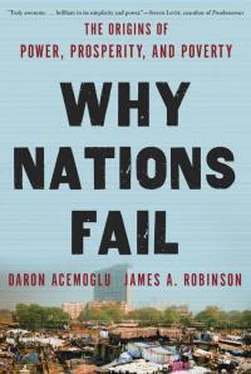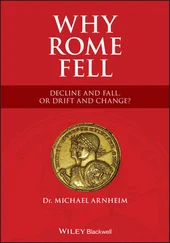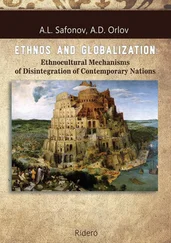In the social science literature there is a great deal of research related to our theory and argument. See Acemoglu, Johnson, and Robinson (2005b) for an overview of this literature and our contribution to it. The institutional view of comparative development builds on a number of important works. Particularly notable is the work of North; see North and Thomas (1973), North (1982), North and Weingast (1989), and North, Wallis, and Weingast (2009). Olson (1984) also provided a very influential account of the political economy of economic growth. Mokyr (1990) is a fundamental book that links economic losers to comparative technological change in world history. The notion of economic losers is very widespread in social science as an explanation for why efficient institutional and policy outcomes do not occur. Our interpretation, which builds on Robinson (1998) and Acemoglu and Robinson (2000b, 2006b), differs by emphasizing the idea that the most important barrier to the emergence of inclusive institutions is elites’ fear that they will lose their political power. Jones (2003) provides a rich comparative history emphasizing similar themes, and Engerman and Sokoloff’s (1997) important work on the Americas also emphasizes these ideas. A seminal political economy interpretation of African underdevelopment was developed by Bates (1981, 1983, 1989), whose work heavily influenced ours. Seminal studies by Dalton (1965) and Killick (1978) emphasize the role of politics in African development and particularly how the fear of losing political power influences economic policy. The notion of political losers was previously implicit in other theoretical work in political economy, for instance, Besley and Coate (1998) and Bourguignon and Verdier (2000). The role of political centralization and state institutions in development has been most heavily emphasized by historical sociologists following the work by Max Weber. Notable is the work of Mann (1986, 1993), Migdal (1988), and Evans (1995). In Africa, work on the connection between the state and development is emphasized by Herbst (2000) and Bates (2001). Economists have recently begun to contribute to this literature; for example, Acemoglu (2005) and Besley and Persson (2011). Finally, Johnson (1982), Haggard (1990), Wade (1990), and Amsden (1992) emphasized how it was the particular political economy of East Asian nations that allowed them to be so economically successful. Finley (1965) made a seminal argument that slavery was responsible for the lack of technological dynamism in the classical world.
The idea that growth under extractive institutions is possible but is also likely to run out of steam is emphasized in Acemoglu (2008).
CHAPTER 4 : SMALL DIFFERENCES AND CRITICAL JUNCTURES
Benedictow (2004) provides a definitive overview of the Black Death, though his assessments of how many people the plague killed are controversial. The quotations from Boccaccio and Ralph of Shrewsbury are reproduced from Horrox (1994). Hatcher (2008) provides a compelling account of the anticipation and arrival of the plague in England. The text of the Statute of Laborers is available online from the Avalon Project, at avalon.law.yale.edu/medieval/statlab.asp
The fundamental works on the impact of the Black Death on the divergence of Eastern and Western Europe are North and Thomas (1973) and particularly Brenner (1976), whose analysis of how the initial distribution of political power affected the consequences of the plague has greatly influenced our thinking. See DuPlessis (1997) on the Second Serfdom in Eastern Europe. Conning (2010) and Acemoglu and Wolitzky (2011) develop formalizations of Brenner’s thesis. The quote from James Watt is reproduced from Robinson (1964), pp. 223–24.
In Acemoglu, Johnson, and Robinson (2005a) we first presented the argument that it was the interaction between Atlantic trade and initial institutional differences that led to the divergence of English institutions and ultimately the Industrial Revolution. The notion of the iron law of oligarchy is due to Michels (1962). The notion of a critical juncture was first developed by Lipset and Rokkan (1967).
On the role of institutions in the long-run development of the Ottoman Empire, the research of Owen (1981), Owen and Pamuk (1999), and Pamuk (2006) is fundamental.
CHAPTER 5 : “I’VE SEEN THE FUTURE, AND IT WORKS”
On Steffens’s mission to Russia and his words to Baruch, see Steffens (1931), chap. 18, pp. 790–802. For the number of people who starved in the 1930s, we use the figures of Davies and Wheatcroft (2004). On the 1937 census numbers, see Wheatcroft and Davies (1994a, 1994b). The nature of innovation in the Soviet economy is studied in Berliner (1976). Our discussion of how Stalinism, and particularly economic planning, really worked is based on Gregory and Harrison (2005). On how writers of U.S. economics textbooks continually got Soviet economic growth wrong, see Levy and Peart (2009).
Our treatment and interpretation of the Lele and the Bushong is based on the research of Douglas (1962, 1963) and Vansina (1978).
On the concept of the Long Summer, see Fagan (2003). An accessible introduction to the Natufians and archaeological sites we mention can be found in Mithen (2006) and Barker (2006). The seminal work on Abu Hureyra is Moore, Hillman, and Legge (2000), which documents how sedentary life and institutional innovation appeared prior to farming. See Smith (1998) for a general overview of the evidence that sedentary life preceded farming, and see Bar-Yosef and Belfer-Cohen (1992) for the case of the Natufians. Our approach to the Neolithic Revolution is inspired by Sahlins (1972), which also has the anecdote about the Yir Yoront.
Our discussion of Maya history follows Martin and Grube (2000) and Webster (2002). The reconstruction of the population history of Copán comes from Webster, Freter, and Gonlin (2000). The number of dated monuments is from Sidrys and Berger (1979).
CHAPTER 6 : DRIFTING APART
The discussion of the Venetian case follows Puga and Trefler (2010), and chaps. 8 and 9 of Lane (1973).
The material on Rome is contained in any standard history. Our interpretation of Roman economic institutions follows Finlay (1999) and Bang (2008). Our account of Roman decline follows Ward-Perkins (2006) and Goldsworthy (2009). On institutional changes in the late Roman Empire, see Jones (1964). The anecdotes about Tiberius and Hadrian are from Finley (1999).
The evidence from shipwrecks was first used by Hopkins (1980). See De Callataǿ (2005) and Jongman (2007) for an overview of this and the Greenland Ice Core Project.
The Vindolanda tablets are available online at vindolanda.csad.ox.ac.uk/. The quote we use comes from TVII Pub. no.: 343.
The discussion of the factors that led to the decline of Roman Britain follows Cleary (1989), chap. 4; Faulkner (2000), chap. 7; Dark (1994), chap. 2.
On Aksum, see Munro-Hay (1991). The seminal work on European feudalism and its origins is Bloch (1961); see Crummey (2000) on Ethiopian feudalism. Phillipson (1998) makes the comparison between the collapse of Aksum and the collapse of the Roman Empire.
CHAPTER 7 : THE TURNING POINT
The story of Lee’s machine and meeting with Queen Elizabeth I is available at calverton.homestead.com/willlee.html.
Allen (2009b) presents the data on real wages using Diocletian’s Edict on Maximum Prices.
Our argument about the causes of the Industrial Revolution is highly influenced by the arguments made in North and Thomas (1973), North and Weingast (1989), Brenner (1993), Pincus (2009), and Pincus and Robinson (2010). These scholars in turn were inspired by earlier Marxist interpretations of British institutional change and the emergence of capitalism; see Dobb
Читать дальше












